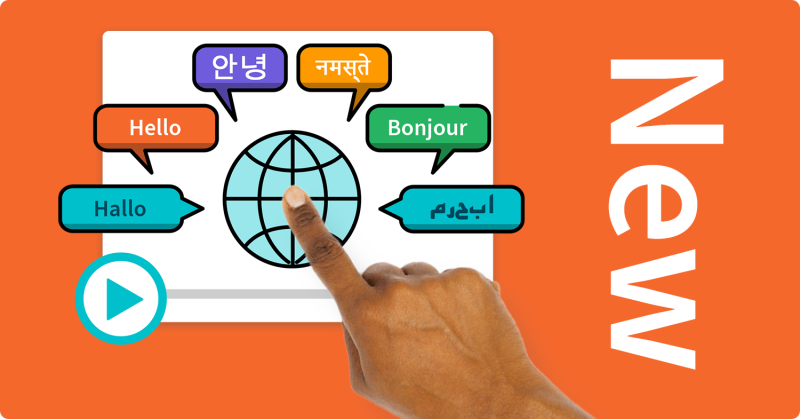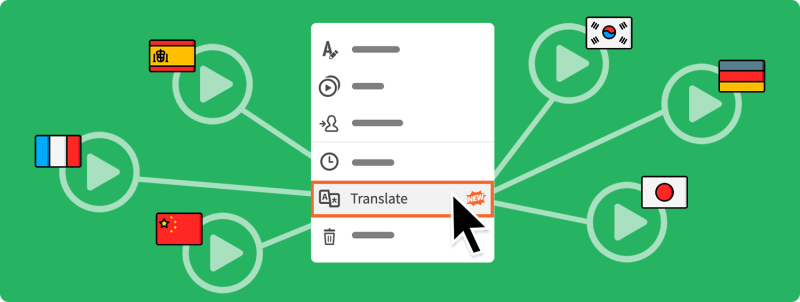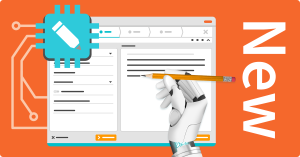New! Translate videos into 20 languages with just one click
Written by Tim Moss | 29th November 2023

Have you ever wondered how to reach a global audience quickly and easily with video? How to you effectively communicate your message across different languages and cultures? How to save time and money while creating high-quality multilingual content?
simpleshow has the perfect solution for you: One-Click Translation.
simpleshow has the perfect solution for you: One-Click Translation.

What makes One-Click Translation so powerful?
One-Click Translation is a revolutionary video translation feature that allows you to convert your content into 20 languages with just one click: no more hassle, no more stress. Just one click, and you’re done. Not only will your video be instantly translated, so will your voice! (We’ll talk more about that in just a moment!)
Sounds too good to be true, right? Well, it’s not. In fact, it’s very simple and very smart. Here’s how it works:
In this video you can see the magic of simpleshow’s powerful video translator:
1. Create your video in your preferred language using simpleshow’s intuitive platform.
Pro tip: if you want to be able to translate your voice along with your video, be sure to record the orginal project directly in the platform (see below for details!).
Pro tip: if you want to be able to translate your voice along with your video, be sure to record the orginal project directly in the platform (see below for details!).
2. Click the “Translate” button and select the languages you want your video translated into. You can choose from 20 languages, including English, Spanish, French, German, Arabic and more.
Sit back and relax while simpleshow’s innovative technology does the magic and translates your video into your target languages.
When you translate a video, your original voiceover can also be translated into your selected languages! If you recorded your original project on the platform, the smart technology will create flawless voiceovers in multiple languages – in your voice. That’s right – your own voice will be the one speaking in all language versions, ensuring a seamless and authentic communication experience across the globe.
When you translate a video, your original voiceover can also be translated into your selected languages! If you recorded your original project on the platform, the smart technology will create flawless voiceovers in multiple languages – in your voice. That’s right – your own voice will be the one speaking in all language versions, ensuring a seamless and authentic communication experience across the globe.
3. Easily invite colleagues or native speakers to collaborate and help add cultural-specific finishing touches to your video.
This gives your content an authentic feel that speaks directly to your audience, no matter where they are in the world. You can also add subtitles to your videos to make them more accessible and user-friendly.
This gives your content an authentic feel that speaks directly to your audience, no matter where they are in the world. You can also add subtitles to your videos to make them more accessible and user-friendly.
And that’s it. You’re done. You’ve just created a video that can speak any language with the click of a button. How awesome is that?

Why is it important to create multilingual content?
We live in a diverse world and focusing on global communication is more important than ever. Explainer videos are an effective way to communicate with your audience and by making them multilingual, you can reach more people and improve the accessibility and inclusivity of your content. This can lead to greater engagement and impact for your brand or message. It also shows a commitment to diversity and inclusivity, which can improve your reputation both with your employees and your customers.
- Increase engagement and loyalty. By making your videos relevant and relatable in different languages, you can communicate more effectively and efficiently as you increase the audience’s engagement and loyalty. People are more likely to watch, like, share and comment on your videos when they feel you understand and care about them. Your videos will resonate with your audience like never before, leading to greater satisfaction and retention. For example, if you want to create a training or learning video for your employees, you can use one-click translation to create videos in different languages that explain the concepts and skills in a clear and simple way. As a result, you can improve the learning outcomes and performance of your audience.
- Demonstrate your commitment to diversity and inclusiveness. By using multilingual videos, you are promoting inclusivity and breaking down language barriers, which can have a positive impact on society and on your brand. Whether you are creating multilingual videos for your diverse employee base or to reach international clients, the willingness to reach out to and include individuals from different linguistic backgrounds shows an understanding and respect for different cultures and languages. This improves the connection people have with your brand.

Simplify your life with One-Click Translation
Because global communication is so important, simpleshow’s goal is to make video creation easier than ever, no matter what language you need to communicate in. Historically, simpleshow clients were limited to full-service offerings for language versions of their videos. Now with our video translation feature, clients are empowered to effortlessly enhance their global communication in the most efficient and professional manner.
With one-click translation, you can save valuable time and money that you would otherwise spend on hiring translators, voice talents, and editors. Our platform allows you to do it all yourself in just minutes, leaving you with more time (and budget!) for other important tasks. For example, if you want to create a video for a social cause, you no longer need to hire a translator or video production team to create multiple videos separately. You can simply create one video in your native language, use one-click translation to instantly create videos in the other languages you need, and focus your time on spreading your message to inspire action. This helps you make a difference faster and more efficiently.
As you can see, One-Click Translation is a game changer for video creation. It’s the ultimate video translation solution that will make your life easier and your content better. Try it today in simpleshow video maker!
FAQs
Voice imitation is a technique that uses advanced AI and machine learning algorithms to create a lifelike digital replica of a human voice. Within simpleshow video maker, we use the original voice to create an imitation in the corresponding language version whenever the original project includes a voice recording. The better the original voice-over is, the better the imitated voice.
In order for your voice-over to be translated, you must have done the original recording directly on the platform. It’s not available if you upload an audio file. You must actively select the consent button when choosing the languages you want to translate.
If you created the original voice recording with your own voice, it is your decision whether you want to use the voice imitation technology. Things become a little more complex when someone else recorded the voice-over in your original video. In this case you need explicit permission from the original speaker. If you are not sure who recorded the voice-over, you can either play the demo in Finalize or open the original project again. Do not give consent to voice imitation, if you don’t have explicit permission from the speaker.
We use the voice-over of the original project to imitate the voice in terms of tonality, speed and sound for the language version. In this process, the voice characteristics of the original sound are adopted to make the generated sound as authentic as possible.
No, you are free to choose whether or not to use voice imitation. If you don’t want to use it, you can either let a native speaker record the voice or use one of the automatic voices. As an account owner, you can also disable voice imitation for your team.
You can currently translate your video into up to 20 languages. Additional languages may be added at a later time. If the language you need is not available, contact us, so our explainer experts can help you create a professional video in any language you may need.
You can recognize the language versions by their unique title (ending with “|” + “Language code”)
Sometimes human expertise is needed. For example, when it comes to adapting units of measurement or the appropriate use of illustrations in different cultures. You can easily invite a native speaker to your project to check these things for you.
No, if you make changes to the original project, you must create a new language version to apply the changes.
To finalize your language version, go to the editing mode of the project. Here, you have the option to thoroughly review your video and make any necessary edits. Once you’re satisfied with the adjustments, simply click the “Finalize video” button to finalize your language version.
We understand that some of the biggest companies in the world exercise extensive caution over fast-developing technologies. While we ensure and stand for responsible use of AI technology, we provide the options to 1) create translations without using the voice imitation feature, 2) allow the admin user of an Enterprise plan to disable the voice imitation feature for their entire team.
If you use simpleshow in an Enterprise team or a Pro plan, you will have access to the One-Click translation feature. Lower account plans need to upgrade to make the feature available to their videos.
The translations of the video scripts are done through a translation service provided by Microsoft Azure.


